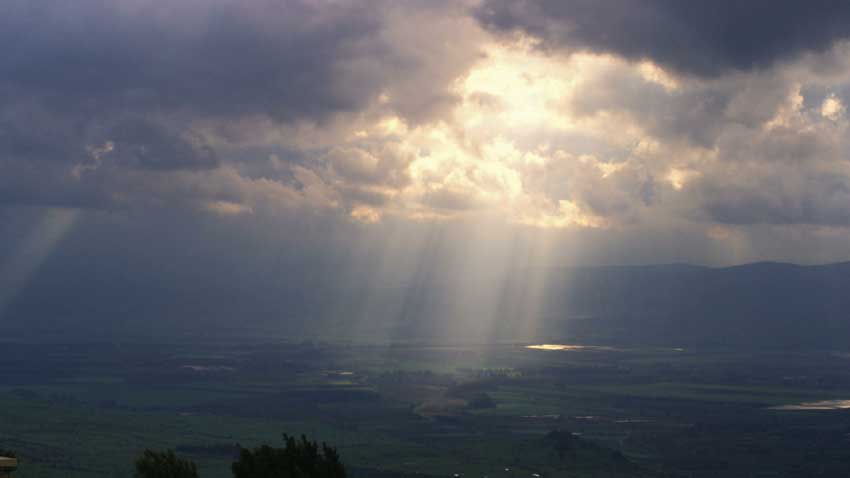In folklore the saint is painted as a very different figure – he is strong, powerful and quick-tempered. He is the master of the summer celestial elements – the clouds, the rain, the thunder, hailstorms… He is evidently heir to the pagan deities, rulers of rain and thunder, Perun and Tangra.
According to legend, when God gave out the world, St. Elijah got the summer thunder and lightning. To protect the crops, he would traverse the skies in a chariot of gold in pursuit of the dragon, because it was the dragon that fed on the wheat. While the bolts of lightning were the flames that came out of the horses’ nostrils and from under their hooves. Or the arrows he used to try and transfix the dragon. So, in folklore tradition he has many names that speak for themselves – Grumovnik, Grumolomnik, Grumodol – all of them derived from the word grum – thunderclap. When he is angry or happy he can work miracles. That is why his sister – St. Mary (some call her Fiery Mary) kept the date of his patron saint’s day a secret from her brother for fear of his unleashing the elements on the world. The saint carries hailstones up his sleeves. And when he encounters sinners or infidels, he works up a hailstorm. St. Mary’s day is two days after Ilinden, on July 22. That is when the church celebrates the memory of Mary Magdalene, the bringer of peace. According to one folklore legend, on her day, Mary put on her best clothes to go to church. She met her brother on the way who asked her where she was going, “Today is my day, so I shall go and light a candle,” she answered. “When will my day come, so I could have some fun too!” St. Elijah sighed. “Your day has come and gone,” his sister laughed.

They call Ilinden “high summer” because it was said July 20 marked a turning point in the weather. People living by the Black Sea say that is when the sea “turns”, to become stormy and cold and claim human lives. That is why on Ilinden fishermen do not go out to sea, and no one bathes in its waters. No work should be done on Ilinden and this is a ban that was, on the whole, observed across the Bulgarian lands. To this day, on July 20, fetes with votive offerings were organized in many towns and villages. According to tradition, the animal sacrificed on this day was the old rooster or “father rooster”. Women would make ritual loaves called bogovitsa or kolach and dedicate them to St. Elijah. In some parts of Southern Bulgaria a bull would be chosen for the sacrifice. The table would be laid near old hallow ground or an age-old tree, close to the village. It was believed that the votive meal on I linden would safeguard the people and the crop from thunder and hailstorms.
There are different stories describing how and where hailstorms are born. In Bulgaria, the guardians of hail are called Krivcho, Slepcho and Gluhcho – derived from the words for blind, deaf and crooked. According to some of the most popular legends, hailstorms are made by what are known as hail-saints. Besides the all-powerful St. Elijah, they include the saints Germain, Bartholomew, Theodore and Elisha. Just as with all natural elements, the ice storms are brought down on men for the sins they have committed, for failure to observe bans on major church holidays or for disrespecting the hail-saints.
Eagles are also thought to be connected with hailstorms. It is said that there is an eagle “leading” every hail-cloud, and that is why eagles’ nests must not be disturbed. Whenever a black cloud appears, the men would take their rifles and take shots at it to frighten the eagle into taking the cloud somewhere else. People also believed that if they were to look at the cloud through the willow-twig wreath they have kept since Palm Sunday or through a sieve, the hailstorm would pass them by. In some parts of Bulgaria, the candle from the St. George’s day lamb would be lit or the first egg dyed red at Easter – taken out of the house.
Ilinden – St. Elijah’s day is a day celebrated by all people named Iliya, Ilian, Iliana and their derivatives – Ilka, Lina, Licho etc. It is also the day of curriers, fur-dressers, saddle and tile makers.
English version: Milena Daynova
Products made of wool inspire the feeling of inner comfort and warmth in the visitors of the Plovdiv Regional Ethnographic Museum. The exhibition "Bulgarian felts - a message from antiquity" presents an ancient craft, which is..
The Hague, a city in the south of the Netherlands, the administrative centre and the place where the Queen lives and works... Hardly anyone associates this city with Bulgarian folklore and traditions. But the fact is that the interest in..
On June 28 and 29th, the city of Razlog, in the region of Blagoevgrad, will present the magic of Bulgarian folklore. In these days, the XIII Festival of traditional horo dance will be held on the central square "Preobrazhenie". The..

+359 2 9336 661
